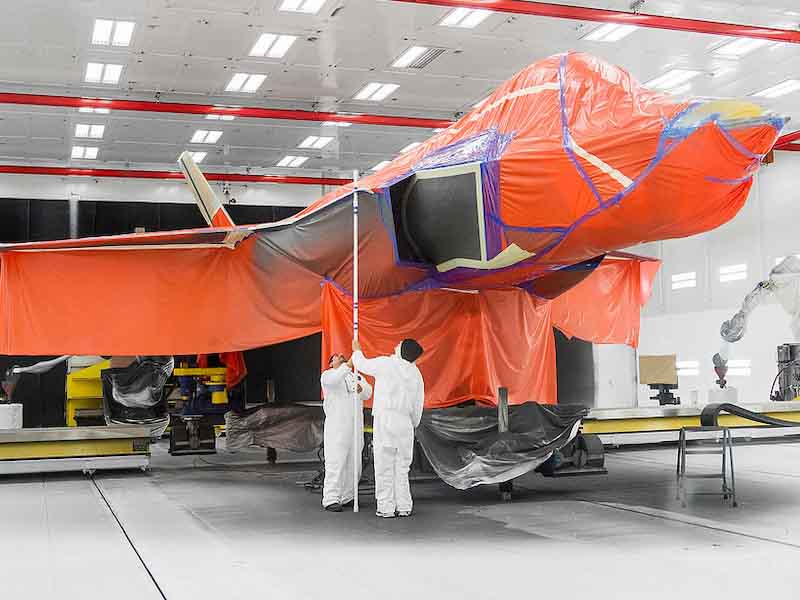MIL-A-8625 - Anodic Coatings for Aluminum and Aluminum Alloys, the primary anodizing specification used in the United States, was revised to MIL-PRF-8625 Revision F and is effective as of Nov. 23, 2020. The specification, as well as previous versions is available for download on the ASSIST online database (assist.dla.mil) and the ASSIST quick search (https://quicksearch.dla.mil/qsSearch.aspx).1
 Dr. Sjon Westre and Dr. Catherine Munson are with CHEMEON Surface Technology in Minden, Nevada.Originally published in 1953, the current revision serves to bring a very useful, but dated, specification into the 21st century. The bulk of the specification remains functionally the same, however there are some changes that anodizers need to be aware of in terms of process, test, and needed procedural updates for auditability. Language was changed or removed in light of recent unintended interpretations of the specification.
Dr. Sjon Westre and Dr. Catherine Munson are with CHEMEON Surface Technology in Minden, Nevada.Originally published in 1953, the current revision serves to bring a very useful, but dated, specification into the 21st century. The bulk of the specification remains functionally the same, however there are some changes that anodizers need to be aware of in terms of process, test, and needed procedural updates for auditability. Language was changed or removed in light of recent unintended interpretations of the specification.
This article reviews the changes in the specification and makes suggestions for action that the anodizer should take to remain compliant to the spec.
Specification Name Change
The name of the specification has been changed to align the spec with its intended function. The “PRF” specifications are defined as performance specifications that state required results without dictating the methods to achieve them. In contrast “STD” specifications are standards for processes and procedures, “DTL” specifications are detail specifications on how a requirement is to be achieved. (McNeil, 2017)
A note about the official specification name: the title lists the name as MIL-PRF-8625 Revision F, with Amendment 2. Unlike previous versions in 1989 and 2003, there is no separate page that is labeled “Amendment.” Rather, the changes incorporated into the entire document comprise Amendment 2. Presumably this allowed the specification holders to maintain the same revision level, “F”, while making substantiative changes to the actual document. (Defense, 2020)
- Recommended anodizer action: search and replace “MIL-A-8625” in all internal quality documents, purchase orders, test reports with “MIL-PRF-8625”. If your quality system requires that you list the revision as well, then the correct title is “MIL-PRF-8625 Rev. F w/amendment 2” or “MIL-PRF-8625F (2)”.
Supersession
Supersession of the specification is clearly defined at the top of the first page of the specification. Unless a customer has specifically stated in their contract or related documents that supersession is not allowed without prior authorization, the anodizer should immediately follow and reference MIL-PRF-8625, Revision F, Amendment 2.
- Recommended anodizer action: review standing contracts for any supersession requirements. Reach out to customers who restrict supersession without approval. For all other customers, immediately follow and reference “MIL-PRF-8625F (2)”.
Changes Within the Specification
Section 1 - Scope
No changes are noted.
Section 2 - Applicable Documents
Table I is a summary of the referenced documents that have changed.
Table I. Changes in MIL-PRF-8625 referenced documents
Section |
Description |
| Federal Standards | Fed-STD-151 deleted |
| Department of Defense Standards | Previously referred to as “Military standards” |
| Department of Defense Specifications |
Previously referred to as military specifications MIL-P-23377 updated to MIL-PRF-23377 MIL-C-81706 updated to MIL-DTL-81706 MIL-P-85582 updated to MIL-PRF-85582 |
| Military Standards |
Mil-STD-105 deleted, replaced with MIL-STD-1916 ASTM D4060 added ASTM E376 added ASTM G 23 deleted, replaced with ASTM G152 ASTM G 26 deleted, replaced with ASTM G155 ASTM D822M added |
| Federal Specifications | QQ-A-250/4 deleted, replaced with SAE AMS4037 |
Oxide Thickness Measurements
Fed-STD-151 has been deleted and now only ASTM B244 and ASTM E 376 are referenced for eddy current measurement of anodic oxide thickness. Either may be used, but control documents and test reports must reference the method used.
Material Specifications
The replacement of QQ-A-250/4 with SAE AMS 4037 is related to test panels. All 2024 test panels must now have heat lot certification to SAE AMS 4037. This is usually not an issue, as the certification will typically state both QQ-A-250/4 and AMS 4037, but it is important to verify that purchase orders and received material documentation show AMS 4037 as the material specification. Otherwise in an audit, the anodizer risks have a finding for lack of material control in purchasing or receiving.
Military Specifications
Military specifications are now labeled Department of Defense Specifications and are updated as follows
- Was: MIL-P-23377, is now: MIL-PRF-23377
- Was: MIL-C-81706, is now: MIL-DTL-81706
- Was: MIL-P-85582, is now: MIL-PRF-85582
MIL-PRF-23377 and MIL-PRF-85582 are paint specifications for the primers that are used in paint adhesion testing within MIL-8625.
MIL-DTL-81706 is the conversion coating specification. Referenced here in relation to touching up anodize scratches and rack marks.
- Recommended anodizer action: References to the documents must be updated in control documents, test reports, purchase orders and receiving documents. A popular audit question is to demonstrate that there is sufficient control of purchasing and receiving. In this case the purchase order and receiving check off must have the relevant MIL-PRF specification listed. Verify that internal control documents discussing methods for touching up scratches on anodize reference MIL-DTL-81706, rather than MIL-C-81706 or MIL-DTL-5541.
Military Standards
The venerable MIL-STD-105 has been replaced with MIL-STD-1916. The specifications are related to statistical sampling for inspection and acceptance of product. If the anodizer was following MIL-STD-105 and its last cancellation notice of 2008, the supersession instructions directed the user to follow MIL-STD-1916 or ANSI/ASQ Z1.4. However, the current revision of MIL-8625 removes the option of following ANSI ASQ Z1.4 - the anodizer must follow MIL-STD-1916. If statistical sampling is employed for product acceptance of anodized parts, a thorough review of MIL-STD-1916 must be performed by the anodizer. It is not the same as MIL-STD-105 or ANSI Z1.4.
ASTM Specifications
ASTM G 23 and 26 are replaced by ASTM G152 and 155, respectively. These specifications, along with ASTM D822/822M deal with weathering and light fastness testing. If lightfastness testing is a part of the anodizer’s customer contracts or purchase orders, the test methods must be updated to the new specifications on purchase orders, test reports, and any internal testing protocols.
ASTM D4060 has replaced Fed-STD-141 Method 6191.1 as the method for abrasion resistance. Note that ASTM D4060 has very specific instructions for the operation of the abraser. If the anodizer is performing abrasion resistance in house, the instructions in ASTM D4060 should be reviewed line by line to be sure that internal instructions match the ASTM Method.
ASTM E376 is included as a method for using an eddy current (thickness) tester.
Section 3 - Requirements
Section 3.3.4 Touchup - Changes the requirement from using a material on QPL-81706 (the list of approved chemical conversion coatings) to using materials in accordance with MIL-DTL-81706. There is minimal effect of this change, at least at initial examination. While MIL-DTL- 81706 provides some application details, reference to MIL-DTL-5541 might have been more appropriate. However, it is possible in the future that MIL-DTL-5541 will be canceled and all conversion coating details will be contained in MIL-DTL-81706.2
Section 3.9 Dimensions of coated articles - deleted. This removes a section that led to an unintended consequence where interpretation of MIL-A-8625 would have required a dimensional verification of parts by the anodizer, rather than a simple thickness measurement.
Section 4 - Quality Assurance
Section 4 is now titled Verification.
Sections 4.1 and 4.1.1 have been deleted, presumably for the same reason that Section 3.9 was deleted above.
Section 4.4 Conformance - The color of Class 2 coatings is now a lot acceptance criterion. The color must be inspected per section 3.6.1. The requirement in 3.6.1 existed in the previous revision, however there is now an explicit instruction to inspect the color per the requirements of the contract, purchase order, or drawing.
The implications are that the anodizer must have a way of confirming the color and that the method must be documented. Accredited anodizers should carefully consider whether or not the inspector has the visual acuity to validate the color by eye. An example is having someone who is colorblind inspecting parts for color. This happens more often than one might think.
Another implication is what is to be done when the purchase order, contract, etc. does not specify how to inspect the color and color uniformity. This eventuality should be handled by the anodizers inspection methods and internal control procedures. This might be a set of “Go/No Go” panels with an acceptable color range on them with documented training for the operators.
Coating thickness measurement for Type III oxides is required in Section 4.4 per section 3.7.2.1 (eddy current or metallurgical cross section). The previous revision of the specification used the words “dimensionally inspected”.
Section 4.5.4 Light fastness - The specifications for light fastness testing are now ASTM D822/822M, ASTM G152, or ASTM G155. ASTM G 26 and ASTM G 23 are no longer referenced.
Section 4.5.5 Abrasion resistance - Previously, the specification listed Method 6192.1 of FED-STD-141 and now refers to ASTM D 4060. The methods are similar however the ASTM methods tend to have more comments and requirements in them. A careful reading of the specification and comparison to the anodizers test method must be completed. For anodizers who send their wear resistance panels out for test, all the traceable paper work (purchase order, test report, etc.) must list ASTM D 4060 as the test method.
Section 6 - The Notes Section
This section is defined as non-mandatory. Unless an anodizer specifically cites and uses a portion of section 6, there should be no audit compliance issues.
General Observations
Formatting
The specification has been reformatted. This, along with changes and deletions, has changed the page numbers between MIL-A-8625F and MIL-PRF-8625F.
A real benefit to anodizers is that while sections were deleted from the specification, the specification was not renumbered. Thus, if an internal quality document refers to section 3.11 in MIL-A-8625F, it will still point to section 3.11 in MIL-PRF-8625F.
- Recommended anodizer action: if any internal documents reference a page number, they should be changed or preferably rewritten so that the document does not rely on page numbers. Failure to update direct references to page numbers will invariably result in at least a minor audit finding for not properly reviewing the specification and your internal documents.
Comment on Internal Specification Review and Quality Systems
Most quality systems (ISO, NADCAP, etc.) require a method of identifying when a specification is revised. If this article is the first time you have heard that MIL-8625 has been revised, examine your quality system to see why it was not caught.
- Recommended anodizer action: shops that are NADCAP certified for chemical processing and use MIL-PRF-8625 should check the PRI website (eauditnet.com) in the coming months as auditors go into shops and report back to PRI. PRI publishes auditor advisories, notes from their meetings, and lists of the top audit findings.
Conclusions
The changes to MIL-A-8625 culminating in the publication of MIL-PRF-8625 do not fundamentally change how anodizing is performed, nor in general the performance requirements. However, the testing and sampling methodologies have been updated to reflect more modern practices. Those anodizers who are NADCAP, ISO, AS certified will benefit from updating their internal quality documents to incorporate these changes.
Footnotes
1. Many anodizers are also utilize the industry site EverySpec (http://everyspec.com/). At the time of publication, EverySpec did not list the updated MIL-PRF-8625.
2. A Revision C draft of MIL-DTL-81706 was recently circulated for comment, where MIL-DTL-5541 was combined with MIL-DTL-81706.
Bibliography
Defense, D. o. (2020, July 16). Defense and Program-Unique Specifications Format and Content. MIL-STD-961E w/Change 4.
McNeil, P. (2017, May 18). The Difference between MIL-STD, MIL-HDBK, MIL-DTL, MIL-PRF and MIL-SPEC. Retrieved from Pasternack Blog: https://blog.pasternack.com/uncategorized/difference-mil-std-mil-hdbk-mil-dtl-mil-prf-mil-spec/
About the Authors
 Dr. WestreDr. Sjon Westre is Senior Vice President of Technology for CHEMEON Surface Technology. He is a leading subject matter expert on the development and commercialization of of hexavalent chrome free corrosion protection chemistries. Since 2016, his recent patents include CHEMEON eTCP and CHEMEON’s pH stable Trivalent Chrome Conversion Coating. Dr. Westre is credited with the MIL-SPEC certification, scale-up formulation and commercialization of CHEMEON TCP-HF (Hexavalent Free) Military, prime contractor, OEM and metal finishers use and purchase the CHEMEON TCP-HF suite of chemistries developed and supported by the team of PhD scientists and chemists that Dr. Westre has assembled.
Dr. WestreDr. Sjon Westre is Senior Vice President of Technology for CHEMEON Surface Technology. He is a leading subject matter expert on the development and commercialization of of hexavalent chrome free corrosion protection chemistries. Since 2016, his recent patents include CHEMEON eTCP and CHEMEON’s pH stable Trivalent Chrome Conversion Coating. Dr. Westre is credited with the MIL-SPEC certification, scale-up formulation and commercialization of CHEMEON TCP-HF (Hexavalent Free) Military, prime contractor, OEM and metal finishers use and purchase the CHEMEON TCP-HF suite of chemistries developed and supported by the team of PhD scientists and chemists that Dr. Westre has assembled.
 Dr. MunsonDr. Catherine Munson is the Research Chemist for CHEMEON Surface Technology. Her thesis dissertation “Electrochemical and Material Characterization of a TCP Conversion Coating on Aluminum Alloy 7075-T6" studies aspects and attributes associated to trivalent chromium chemicals as a conversion coating on aluminum and other light metals. Her deep understanding of trivalent chrome chemistry is a key differentiator in CHEMEON’s commitment to new product development and technical support. Dr. Munson has been part of a growing team of scientists being assembled by CHEMEON’s Senior VP of Technology Dr. Sjon Westre since 2017.
Dr. MunsonDr. Catherine Munson is the Research Chemist for CHEMEON Surface Technology. Her thesis dissertation “Electrochemical and Material Characterization of a TCP Conversion Coating on Aluminum Alloy 7075-T6" studies aspects and attributes associated to trivalent chromium chemicals as a conversion coating on aluminum and other light metals. Her deep understanding of trivalent chrome chemistry is a key differentiator in CHEMEON’s commitment to new product development and technical support. Dr. Munson has been part of a growing team of scientists being assembled by CHEMEON’s Senior VP of Technology Dr. Sjon Westre since 2017.
About CHEMEON Surface Technology
CHEMEON Surface Technology is a global leader in advanced, environmentally responsible, surface engineering solutions. CHEMEON is licensed by the US Navy to manufacture and provide MIL-SPEC QPL Trivalent Chromium Pre-Treatment; CHEMEON TCP-HF® (Hex Free), CHEMEON TCP-HF EPA (Extended Protection Additive), CHEMEON TCP-HF SP (Spray) and CHEMEON TCP-HF Touch Up Pen. CHEMEON's patented and proprietary chemistries include: Military Grade CHEMEON TCP-NP™ (No Prep) and patented zero chrome CHEMEON 0CP- 6800, in addition to a full line of anodizing pre and post treatments, additives, dyes, custom R&D, consulting and university level training. Visit CHEMEON.com



































